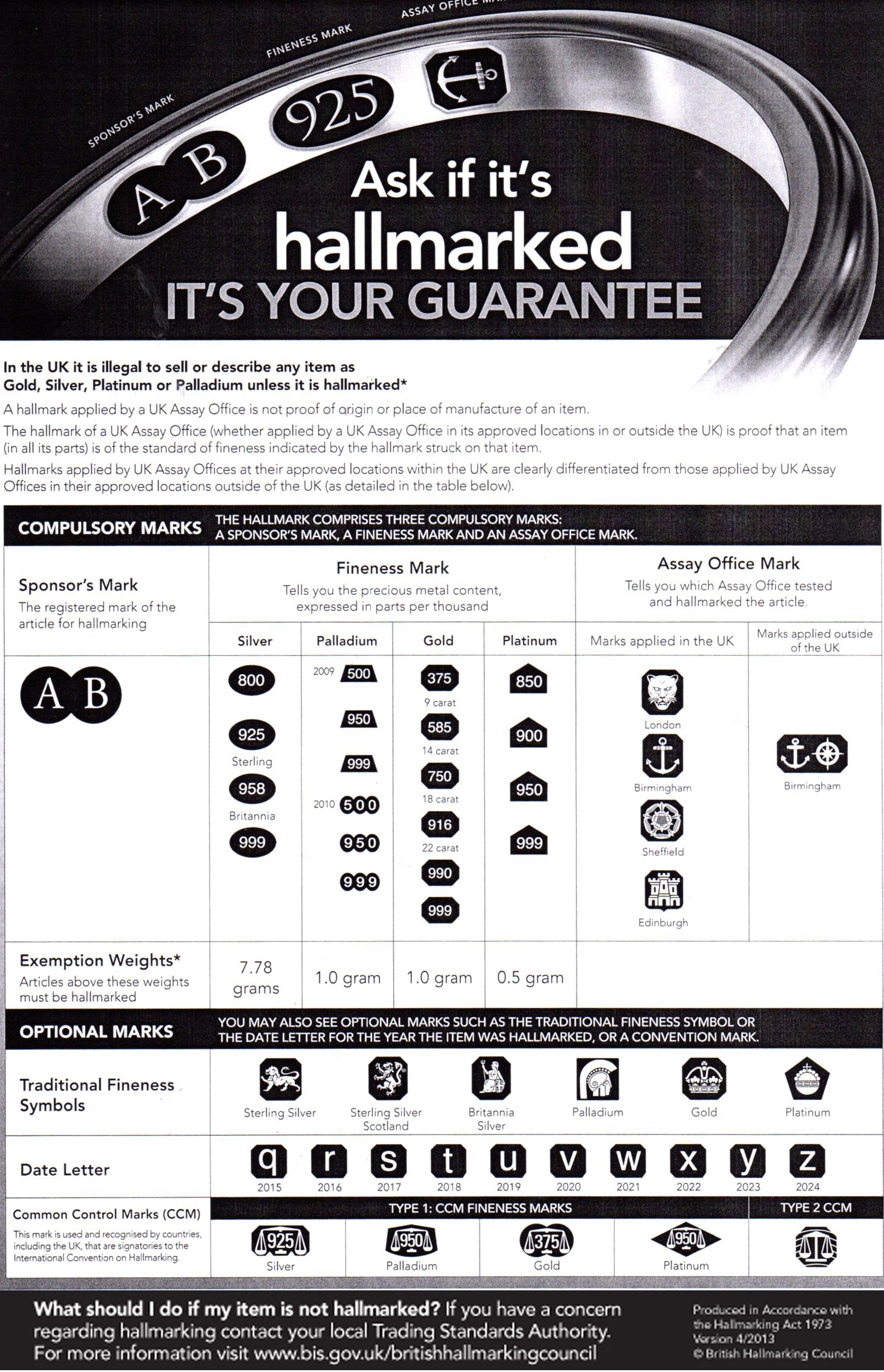Precious metals and hallmarks
Jewellery that carries a British standard hallmark does NOT mean that it was made in Britain.
Items can be imported to Britain and given a 'British' hallmark.
It no longer even means that it was hallmarked in Britain, as the 'Birmingham' assay office have opened an office in Mumbai, India. Where jewellery made there will carry a variation of the 'Birmingham' Anchor symbol.
Because of the softness of pure (24k) gold, it is usually alloyed with base metals for use in jewellery, altering its hardness and ductility, melting point, color and other properties. Alloys with lower caratage, typically 22k, 18k, 14k or 10k, contain higher percentages of copper, or other base metals or silver or palladium in the alloy.
Copper is the most commonly used base metal, yielding a redder color. Eighteen-carat gold containing 25% copper is found in antique and Russian jewellery and has a distinct, though not dominant, copper cast, creating rose gold. Fourteen-carat gold-copper alloy is nearly identical in color to certain bronze alloys.
White gold alloys can be made with palladium or nickel. White 18-carat gold containing 17.3% nickel, 5.5% zinc and 2.2% copper is silvery in appearance. Nickel is toxic, however, and its release from nickel white gold is controlled by legislation in Europe. Alternative white gold alloys are available based on palladium, silver and other white metals, but the palladium alloys are more expensive than those using nickel. High-carat white gold alloys are far more resistant to corrosion than are either pure silver or sterling silver.
At Victoria James we prefer to use only high Palladium based gold alloys, not only does this mean it is nickel free but that our 18ct white gold retains its white colour.
Current Gold Standards
Many of our jewellery items are available in the following gold purities:

Gold items under 1 gram are exempt from the legal requirement to bare a hallmark.
GOLD COLOUR
By using different metals in the gold alloy, a wide range of shades and clours can be achieved:
Yellow gold - alloyed with other metals maintaining a rich golden colour.
White gold - alloyed with white metals, for example silver or palladium to give a silvery finish.
Rose gold - alloyed with metals such as copper to give a reddish tint.
Platinum is traditionally the most desirable white precious metal due to it's hard wearing and hypo-allergenic properties.
Platinum is a grey-white precious metal. Platinum was brought within hallmarking regulations in 1975.
Current Platinum Standards

Platinum items under 0.5 gram are exempt.
Under the 2005 legislation any manufacturer, importer, wholesaler or retailer in the supply chain will commit an offence if:
They sell a post assembly intended to be inserted into a pierced part of the human body unless the rate of nickel release from the post assembly is less than 0.2 µg/cm2/week;
They sell jewellery items, including certain metal clothing fasteners, if the rate of nickel release from those parts of the product which come into direct and prolonged contact with the skin is greater than 0.5 µg/cm2/week.
They sell any jewellery items, including certain metal clothing fasteners, where these have a non-nickel coating unless the coating is sufficient to ensure that the rate of nickel release from those parts of the product which come into direct and prolonged contact with the skin does not exceed 0.5 µg/cm2/week for a period of at least two years normal use of the product.
At Victoria James we prefer to use only high Palladium based gold alloys, not only does this mean it is nickel free but that our 18ct white gold retains its white colour.
Current Silver Standards

Silver items under 7.78 grams are exempt.
Palladium has been officially acknowledged as the latest precious metal trend for the fine jewellery industry with the advent of a hallmark to guarantee its fineness.
From 22nd July 2009, the four UK Assay Offices can mark Palladium articles with a legally recognised Hallmark, applied under an amendment to the Hallmarking Act 1973.
The interest in Palladium both within the jewellery trade and among consumers has grown strongly in recent years, driven by an increased demand for quality jewellery in white precious metal.
Palladium, one of the platinum group metals is tarnish resistant, white and durable. However, it is not a dense metal and can therefore dent or mark quite easily compared to Platinum or 18ct gold.

A hallmark is an official mark or series of marks struck on items made of precious metals — platinum, gold, silver and palladium.
As it now stands, the compulsory part of the UK hallmark consists of the sponsor or maker's mark, the assay office mark and the standard of fineness.
Hallmarking involves testing articles made of precious metal and marking them to indicate that they are of a minimum standard of purity.

Jewellery that carries a British standard hallmark does NOT mean that it was made in Britain.
Items can be imported to Britain and given a 'British' hallmark.
It no longer even means that it was hallmarked in Britain, as the 'Birmingham' assay office have opened an office in Mumbai, India. Where jewellery made there will carry a variation of the 'Birmingham' Anchor symbol. (see chart above)
